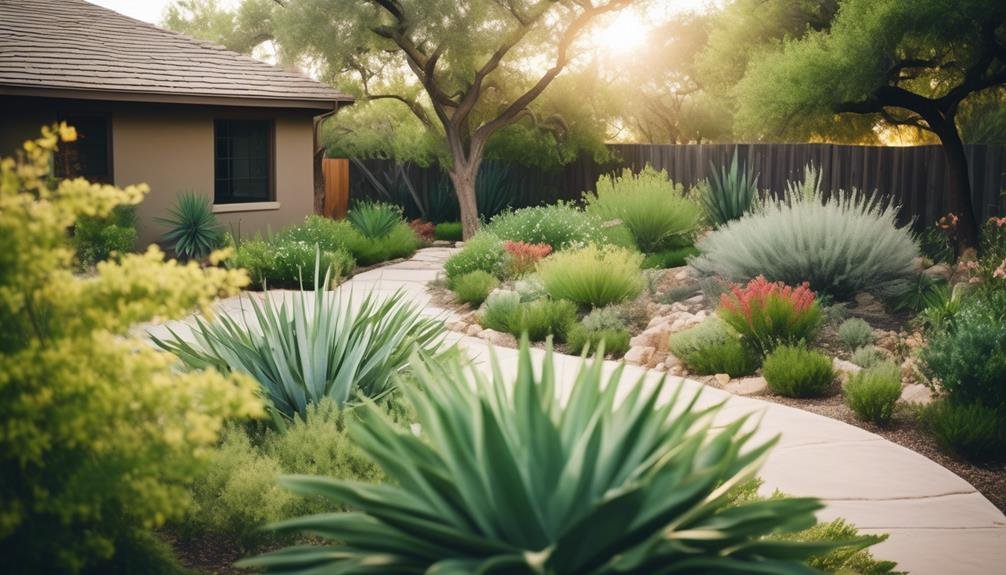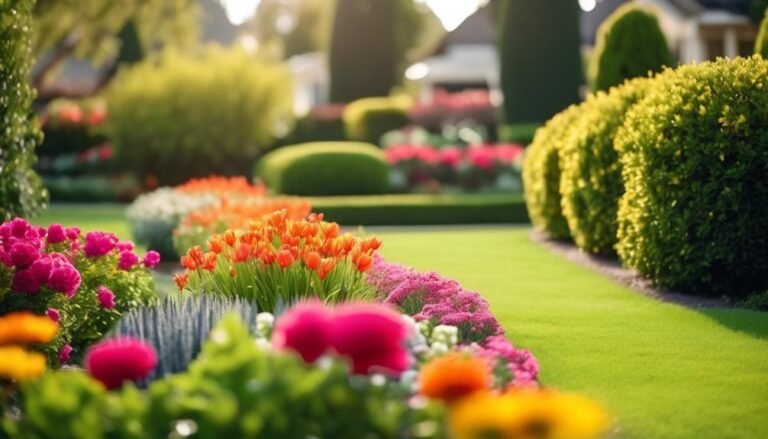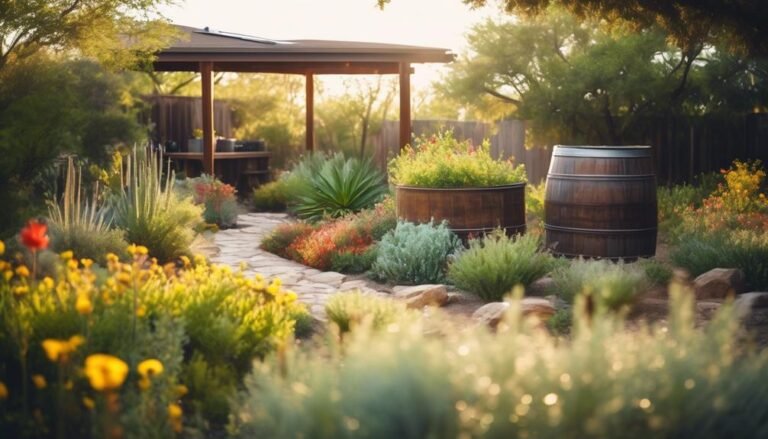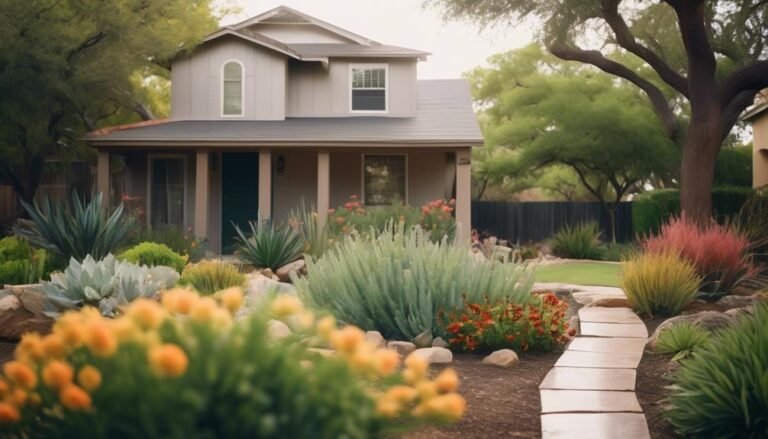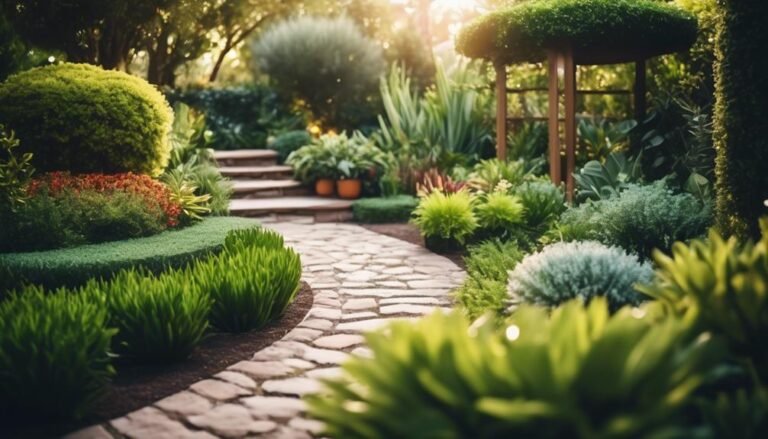15 Green Landscaping Solutions for San Antonio Yards
Want to spruce up your San Antonio yard while being eco-friendly? Consider these 15 green landscaping solutions.
They not only boost the look of your yard but also help the environment.
From picking plants that can handle drought to adding renewable energy features, these solutions offer practical and eco-friendly options for your outdoor space.
Each one gives you a chance to beautify your yard and make a positive impact on the local environment.
Key Takeaways
Sprucing up your San Antonio yard while being eco-friendly? Consider these 15 green landscaping solutions.
They not only enhance the look of your yard but also benefit the environment.
Choosing plants that can withstand drought and adding renewable energy features offer practical and eco-friendly options for your outdoor space.
Each solution gives you a chance to beautify your yard and make a positive impact on the local environment.
Drought-Tolerant Plant Selection
Choosing drought-tolerant plants for your San Antonio yard is a smart way to reduce the need for frequent watering and create a sustainable and resilient landscape. These plants are well-adapted to arid conditions, which means they require less water to thrive. By opting for drought-tolerant plants, you can have a beautiful garden while conserving water and promoting a more sustainable environment.
The hot and dry climate of San Antonio makes it important to select plants with low water requirements. Drought-tolerant plants have evolved to survive in conditions where water is scarce, making them perfect for creating a resilient landscape in your yard.
When you choose drought-tolerant plants, you not only save water but also support sustainable landscaping practices. These plants can flourish with minimal watering, giving you the freedom to enjoy a lush yard without constant maintenance. By selecting plants that are well-suited to San Antonio's climate, you're ensuring that your garden remains resilient even during periods of drought.
Embracing drought-tolerant plant selection is a proactive step towards creating a sustainable and thriving landscape in your San Antonio yard.
Rainwater Harvesting Systems
Considering a rainwater harvesting system for your San Antonio yard can be a great way to make the most of rainwater for your sustainable needs. These systems offer an environmentally friendly way to manage your landscape by reducing your reliance on city water.
By capturing and storing rainwater, these systems not only help save water but also prevent erosion and pollution. You can use the collected rainwater for watering your plants, gardening, and other non-drinking household purposes, which promotes a more sustainable approach to water usage.
Additionally, installing a rainwater harvesting system might make you eligible for rebates, incentives, or LEED certification, helping you save on costs while supporting sustainability.
Native Plant Landscaping
Want to create a sustainable and resilient outdoor space in your San Antonio yard? Consider using native plant landscaping. Native plants are well-suited to the natural rainfall in the area, so they require less watering. Plus, their deep roots help prevent soil erosion and improve water absorption.
Using native plants in your landscaping can give your yard a unique and authentic look that reflects San Antonio's natural beauty. These plants also attract local pollinators and wildlife, adding vibrancy to your yard.
Solar-Powered Outdoor Lighting
Want to brighten up your outdoor space with eco-friendly and cost-effective lighting? Solar-powered outdoor lighting is the perfect solution. It harnesses energy from the sun, providing illumination while reducing electricity costs and environmental impact.
In San Antonio, solar-powered outdoor lighting is a practical and sustainable choice for homeowners looking to enhance their landscaping.
With easy installation and minimal maintenance, solar-powered outdoor lighting is hassle-free and budget-friendly. It not only contributes to a greener environment but also adds an extra layer of security and safety by lighting up pathways, driveways, and outdoor areas.
The diverse styles and designs available allow you to customize the lighting to complement the aesthetic appeal of your landscape. Whether you want a cozy ambiance or a well-lit outdoor entertainment space, solar-powered outdoor lighting can meet your needs.
Say goodbye to the hassle of wiring and the ongoing cost of electricity. Embrace the freedom of lighting up your outdoor space with solar power, knowing you're making a positive impact on the environment and your wallet.
Permeable Paving Solutions
Are you looking for ways to improve your yard with eco-friendly landscaping options? Permeable paving is a great choice that offers several benefits, such as reducing runoff and preventing flooding.
It's important to consider the installation process and maintenance tips to make sure it's a successful and sustainable option for your San Antonio yard.
When it comes to eco-friendly landscaping, permeable paving is a fantastic choice. It helps to reduce runoff and prevents flooding, making it a great option for your yard in San Antonio.
But it's important to understand the installation process and maintenance tips to ensure it's the right fit for your home.
Benefits of Permeable Paving
Permeable paving is a great choice for your landscape because it has numerous environmental benefits. When you use permeable paving, you help the environment in many ways:
- Environmental Impact
- Allows water to soak into the ground, which reduces stormwater runoff and helps with drainage problems.
- Helps to refill groundwater, prevents erosion, and reduces flooding.
- Water Quality and Sustainability
- Filters out pollutants and contaminants from stormwater, making the water cleaner.
- Reduces the heat island effect, which supports healthy plant growth and sustainable landscaping.
Installation Considerations
Considering the installation of permeable paving solutions? Keep in mind that accessibility and geographical limitations play a crucial role in the process.
It's important to prioritize accessibility, as restricted access can affect the effectiveness of permeable paving solutions. Consider how often the site might be unavailable and plan for alternative strategies. VPNs and proxy servers can help overcome site inaccessibility, so it's important to factor them into your installation planning for permeable paving solutions.
Global efforts to promote internet freedom can also impact the installation and effectiveness of permeable paving solutions.
Maintenance Tips
Maintaining the effectiveness of permeable paving is important for managing water runoff. Here are some tips for keeping your permeable paving in top shape:
- Use a gentle pressure wash or vacuum to remove debris from the surface.
- Avoid using strong chemicals that can affect the paving's ability to let water through.
- Regularly check for any signs of clogging and clear any blockages to ensure proper water drainage.
Organic Lawn Care Practices
When it comes to taking care of your lawn, organic practices can make a big difference. Instead of using harsh chemicals, organic lawn care focuses on natural and non-toxic methods to keep your lawn healthy and vibrant.
By using organic fertilizers, compost, and natural soil amendments, you can help your soil stay healthy and your grass grow lush. Choosing natural pest control and weed management methods over synthetic pesticides and herbicides keeps your yard chemical-free.
Regularly aerating and overseeding with native grass species are important for creating a strong and sustainable lawn. These practices not only help you maintain a beautiful lawn but also support a healthier environment by reducing the impact on the environment and promoting biodiversity in your yard.
Implementing organic lawn care practices not only enhances the beauty of your yard but also supports a thriving ecosystem, benefiting both the environment and your outdoor space.
Composting and Mulching Techniques
Get ready to learn about the benefits of composting and different mulching techniques for your home.
Composting is a great way to enrich your soil with natural materials, reducing the need for synthetic fertilizers. You can use a variety of materials to create your own compost, such as food scraps, yard waste, and leaves.
Mulching is also important for homeowners as it helps conserve soil moisture and prevents weed growth. You can use materials like wood chips, straw, leaves, and grass clippings for mulching.
These techniques can help improve the health of your garden and make your yard more sustainable.
Benefits of Composting
Composting is a great way to improve your soil and make your yard more resilient. It reduces the need for chemical fertilizers and pesticides, making your plants healthier. Plus, it's better for the environment too! When you compost, you help reduce greenhouse gas emissions and keep organic waste out of landfills.
Composting enriches your soil by adding essential nutrients, which helps your plants grow better and retain more water. It's an easy way to make a positive impact on your yard and the world around you.
Types of Mulching
Let's talk about different mulching techniques that can help improve the health and resilience of your yard. There are various options to choose from, each with its own benefits. Here's a quick overview to help you decide which mulching technique suits your preferences and needs:
| Type of Mulch | Description | Benefits |
|---|---|---|
| Organic Mulch | Examples: wood chips, leaves. Enriches soil, improves moisture retention. | Enriches soil, improves moisture retention |
| Inorganic Mulch | Examples: gravel, pebbles. Provides long-lasting weed control, drainage benefits. | Long-lasting weed control, drainage benefits |
| Composting | Uses kitchen scraps, yard waste. Creates nutrient-rich soil amendments. | Creates nutrient-rich soil amendments |
| Newspaper/Cardboard | Suppresses weeds, retains soil moisture in garden beds. | Suppresses weeds, retains soil moisture |
These mulching options give you the freedom to choose the best fit for your yard's needs.
Application Techniques
When it comes to taking care of your yard, it's important to consider the specific needs of your soil and plants. By using composting and mulching techniques, you can support soil health and plant growth in a sustainable and eco-friendly way.
Start by layering organic materials like leaves, grass clippings, and food scraps to create nutrient-rich compost. Flatten each layer as you go to help the compost break down effectively.
For mulching, use natural materials like wood chips or straw to suppress weeds and regulate soil temperature. Simply layer the mulch around your plants to provide these benefits.
Eco-Friendly Fertilization Methods
Want to keep your yard healthy and vibrant while being kind to the environment? You should consider using eco-friendly fertilization methods. These methods use natural materials and processes to keep your soil healthy and nourish your plants. By choosing eco-friendly fertilization, you can take a more sustainable approach to yard care.
These methods focus on nourishing your yard without using synthetic chemicals, which can harm the ecosystem. By promoting soil health and using natural processes, eco-friendly fertilization methods help create a healthier and more balanced yard ecosystem.
By embracing these practices, you can take a more natural and harmonious approach to yard care, which aligns with your desire for eco-conscious and responsible landscaping. With eco-friendly fertilization methods, you can have a lush and thriving yard while minimizing environmental impact and supporting a healthier ecosystem.
Choosing these methods promotes sustainable practices and contributes to the well-being of your yard and the environment.
Water-Efficient Irrigation Options
Looking to save water while keeping your yard healthy? There are some efficient irrigation options for your San Antonio yard:
- Drip Irrigation Systems: These systems target watering to minimize water waste and promote plant health. By delivering water directly to the roots, they save water and help plants thrive.
- Smart Irrigation Controllers: These controllers adjust watering based on weather and plant needs, saving water. They use data to make sure your yard gets the right amount of water at the right time, reducing unnecessary water use.
Other water-efficient irrigation methods include:
- Rainwater Harvesting Systems: These systems collect and store rainwater for later use in yard irrigation, reducing reliance on city water.
- Low-Volume Irrigation Systems: Systems like soaker hoses and micro-sprinklers deliver water directly to plant roots, saving water.
Using these water-efficient irrigation options with native and drought-tolerant plants can reduce the need for frequent watering, keeping your yard healthy and sustainable.
Vertical Gardening Strategies
Transform your San Antonio yard with clever vertical gardening strategies that make the most of walls, trellises, or other vertical structures. These strategies are a practical way to maximize your outdoor space, especially in smaller yards. By growing plants upward, you can add plenty of greenery and blooms without taking up valuable ground space.
Vertical gardening not only saves space, but it also enhances the look of your outdoor area, creating a lush and visually appealing landscape. Whether you want to grow herbs, vegetables, or flowers, vertical gardening allows for a diverse range of plants in a limited area.
Embracing these strategies lets you turn bare walls and fences into thriving gardens, adding a touch of natural beauty to your outdoor environment. With vertical gardening, you can unleash your creativity and experiment with various plant combinations and arrangements, turning your yard into a vibrant and enchanting oasis.
Habitat Restoration and Wildlife Gardens
Creating a thriving wildlife habitat in your San Antonio yard is essential for supporting local wildlife and promoting biodiversity in the 78223 area. Here's how you can make a difference:
- Choose Native Species: Pick plants, trees, and shrubs that are native to the region. Native species are well-suited to local conditions and provide vital food and shelter for native wildlife.
- *Benefits of Native Species*: Native plants require less water and maintenance, reducing the need for chemical inputs and preserving the natural balance of the ecosystem.
- Create Diverse Layers: Include a variety of vegetation layers, such as ground cover, shrubs, and canopy trees. This approach mimics natural habitats and supports a wider range of wildlife, from ground-dwelling insects to canopy-dwelling birds.
Low-Maintenance Landscape Design
As a homeowner with a busy schedule, you want a yard that looks great without demanding too much time and effort. A low-maintenance landscape design can make this a reality.
By choosing plants that can withstand dry conditions and using xeriscaping techniques, you can minimize the need for frequent watering and upkeep. Opting for native plants that thrive in San Antonio's climate is a smart choice too.
Adding elements like gravel, rocks, and mulch can also reduce the need for regular lawn care. Strategically placing plants, shrubs, and trees not only adds visual appeal but also minimizes maintenance requirements.
Ready to bring your low-maintenance yard to life? Call 210-494-6469 to schedule a consultation with our experts in low-maintenance landscape design.
And here are some extra tips for creating a low-maintenance landscape design:
- Choose drought-resistant plants
- Use xeriscaping techniques
- Incorporate hardscaping elements
- Opt for native plants and trees
- Plan strategic plant placement
Renewable Energy Features
Looking to reduce maintenance and environmental impact in your yard? You might want to consider adding renewable energy features like solar panels, wind turbines, and geothermal heating and cooling systems. These features can help power your outdoor lighting, heating, and cooling systems while reducing your reliance on traditional energy sources.
Here's why integrating renewable energy features into your yard is a smart move:
- Solar panels: Capture the sun's energy to power your home and lower your electricity bills.
- Long-term cost savings: While the initial investment can be significant, solar panels can significantly lower your energy bills over time.
- Environmental impact: By using solar energy, you can reduce your carbon footprint and contribute to a cleaner environment.
- Wind turbines: Utilize wind power to generate electricity for your outdoor lighting and other electrical needs.
- Energy independence: With wind turbines, you can become less reliant on traditional energy sources and gain more freedom in powering your outdoor space.
- Sustainable energy: Wind power is a clean and sustainable energy source that can contribute to a greener environment.
Incorporating renewable energy features not only benefits the environment but also gives you the freedom to power your yard in a sustainable and cost-effective manner.
Sustainable Hardscaping Materials
Thinking about revamping your yard? How about using sustainable hardscaping materials to create a beautiful and eco-friendly outdoor space? Materials like recycled concrete, reclaimed wood, and natural stone offer a range of benefits.
Not only do they look great, but they also help reduce environmental impact, conserve natural resources, and minimize waste in landfills. Plus, these materials are durable, low-maintenance, and provide long-lasting solutions for your outdoor spaces.
Using sustainable hardscaping materials isn't just about creating a nice-looking yard – it's also about being environmentally conscious. By choosing these materials, you can make a positive impact on the environment while enhancing the aesthetic appeal of your yard.
Whether you're thinking of adding a patio, walkway, or retaining wall, incorporating sustainable hardscaping materials can help you achieve a beautiful and sustainable outdoor space that reflects your commitment to environmental responsibility. So, why not consider these materials for your next outdoor project?
Green Roof and Living Wall Installations
Are you looking to enhance your outdoor space in San Antonio with eco-friendly features? Green roof and living wall installations can offer both a beautiful look and important environmental benefits.
By adding a green roof or living wall to your home, you can lower your energy costs and improve the air quality around your property. These installations also help to reduce the urban heat island effect and prevent stormwater runoff, which promotes sustainable urban development.
In addition to the environmental advantages, green roofs and living walls create natural habitats for birds, insects, and other wildlife. This contributes to urban biodiversity, making San Antonio a healthier and more sustainable place to live.
Frequently Asked Questions
How Do I Keep My Grass Green in San Antonio?
Want to keep your grass looking lush and green in San Antonio? Here are a few tips for homeowners like you.
Water your lawn deeply and not too often, either early in the morning or late in the evening. This helps prevent the water from evaporating too quickly.
Regular fertilization is also important for keeping your grass healthy and vibrant. Make sure to mow your lawn at the right height and consider aerating it for even better results. These simple steps can make a big difference in the appearance of your lawn.
How Can I Landscape My Yard Without Grass?
Want to landscape your yard without grass? Consider xeriscaping, a water-wise approach that focuses on using low-water plants and materials. You can use xeriscaped mulch, artificial turf, or decorative options like cement patios or shade structures. By choosing native plants, you can create a beautiful, sustainable landscape that requires less water and maintenance. Seek professional services to ensure a healthy, thriving yard that complements your home.
How Do I Landscape My Front Yard on a Budget?
Landscaping your front yard on a budget can be done by using xeriscaping techniques, which focus on water-efficient plants and designs. You can also incorporate native plants, which are well-suited to your local climate and require less maintenance. Adding low-cost decorative elements like rocks and mulch can enhance the look of your yard without breaking the bank. It's important to do your own maintenance to save money, and sourcing affordable plants from local nurseries can help you stay within your budget. By being mindful of these tips, you can create a beautiful front yard without spending a fortune.
How Do You Make Green Landscape?
Creating a green landscape for your yard involves using environmentally friendly materials and plants, such as xeriscaped mulch and native plants. These choices not only add a breath of fresh air to your yard but also require less maintenance and help save water, making them a great option for homeowners looking to beautify their outdoor space while also being mindful of the environment.

